Dogon

The Dogon are an ethnic group located mainly in the administrative
districts of Bandiagara and Douentza in Mali, West Africa.
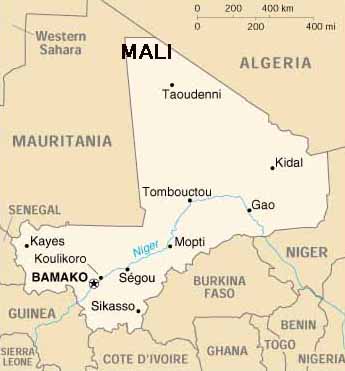
This area is composed of three distinct topographical regions: the plain, the cliffs, and the plateau.
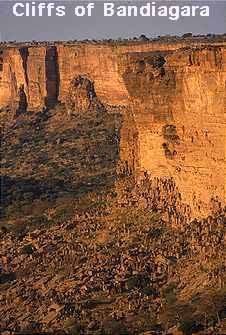
Within these regions the Dogon population of about 300,000 is most heavily concentrated
along a 200 kilometer (125 mile) stretch of escarpment called the Cliffs of Bandiagara.
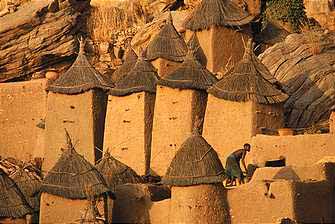
These sandstone cliffs run from southwest to northeast, roughly parallel
to the Niger River, and attain heights up to 600 meters (2000 feet).
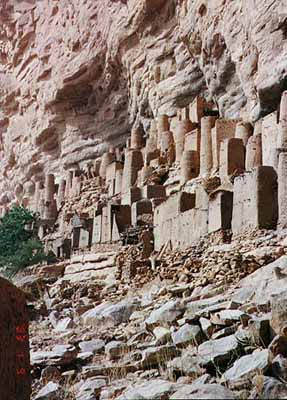
The cliffs provide a spectacular physical setting for Dogon villages built on the sides of the escarpment.
There are approximately 700 Dogon villages, most with fewer than 500 inhabitants.
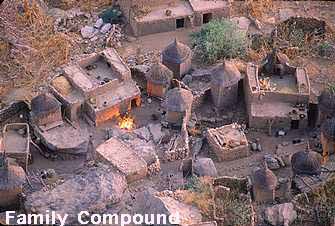
A Dogon family compound in the village of Pegue is seen from the top of the Bandiagara escarpment.
During the hot season, the Dogon sleep on the roofs of their earthen homes.
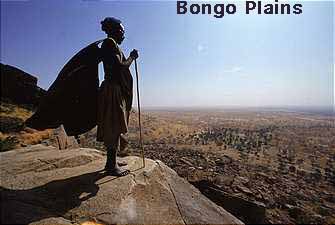
Abdule Koyo, a Dogon man, stands on the top of the Bandiagara escarpment that overlooks the Bongo plains. As the rocky land around the Bandiagara has become less and less fertile, the Dogon have moved farther from the cliffs. Millet cultivation is more productive in the fertile Bongo plains.
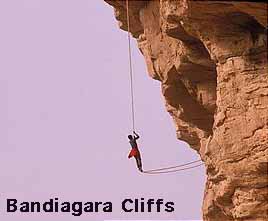
Without any equipment but his own muscle and expertise, a Dogon man climbs hundreds of meters above the ground. Ireli villagers use ropes made of baobab bark to climb the Bandiagara cliffs in search of pigeon guano and Tellem artifacts. The pigeon guano is used as fertilizer and can be sold at the market for $4 per sack. The Tellem artifacts, such as brass statues and wooden headrests, bring high prices from Western art collectors.
The precise origin of the Dogon, like those of many other ancient cultures, is undetermined. Their civilization emerged, in much the same manner as ancient Sumer, both sharing tales of their creation by gods who came from the sky in space ships, who allegedly will return one day
The early histories are informed by oral traditions that differ according to the Dogon clan being consulted and archaeological excavation much more of which needs to be conducted.
Because of these inexact and incomplete sources, there are a number of different versions of the Dogon's origin myths as well as differing accounts of how they got from their ancestral homelands to the Bandiagara region. The people call themselves 'Dogon' or 'Dogom', but in the older literature they are most often called 'Habe', a Fulbe word meaning 'stranger' or 'pagan'.
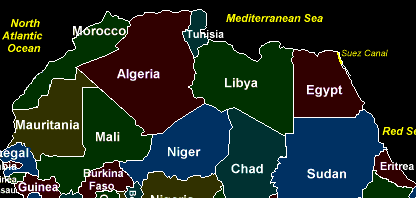
Certain theories suggest the tribe to be of ancient Egyptian descent - the Dogon next migrating to the region now called Libya, then moving on to somewhere in the regions of Guinea or Mauritania.
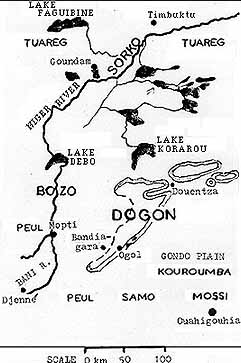
Around 1490 AD, fleeing invaders and/or drought, they migrated to the Bandiagara cliffs of central Mali. Carbon-14 dating techniques used on excavated remains found in the cliffs indicate that there were inhabitants in the region before the arrival of the Dogon. They were the Toloy culture of the 3rd to 2nd centuries BC, and the Tellem culture of the 11th to 15th centuries AD.
The religious beliefs of the Dogon are enormously complex and knowledge of them varies greatly within Dogon society. Dogon religion is defined primarily through the worship of the ancestors and the spirits whom they encountered as they slowly migrated from their obscure ancestral homelands to the Bandiagara cliffs. They were called the 'Nommo' - [see below and on the file Amphibious Gods]
There are three principal cults among the Dogon; the Awa, Lebe and Binu.
The Awa is a cult of the dead, whose purpose is to reorder the spiritual forces disturbed by the death of Nommo, a mythological ancestor of great importance to the Dogon.
Members of the Awa cult dance with ornate carved and painted masks during both funeral and death anniversary ceremonies. There are 78 different types of ritual masks among the Dogon and their iconographic messages go beyond the aesthetic, into the realm of religion and philosophy.
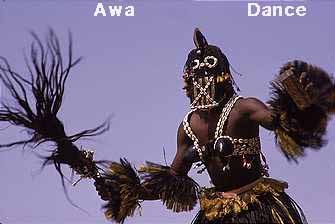
The primary purpose of Awa dance ceremonies is to lead souls of the deceased to their final resting place in the family altars and to consecrate their passage to the ranks of the ancestors.
The cult of Lebe, the Earth God, is primarily concerned with the agricultural cycle and its chief priest is called a Hogon.
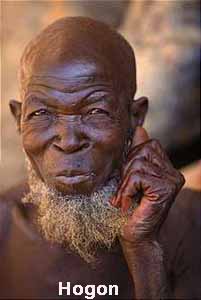
All Dogon villages have a Lebe shrine whose altars have bits of earth incorporated into them to encourage the continued fertility of the land.
According to Dogon beliefs, the god Lebe visits the hogons every night in the form of a serpent and licks their skins in order to purify them and infuse them with life force. The hogons are responsible for guarding the purity of the soil and therefore officiate at many agricultural ceremonies. [Serpent is a metaphor for DNA]
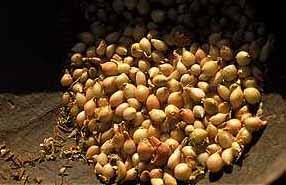
In the village of Sangha, onion bulbs are smashed and shaped into balls that are dried in the sun. The onion balls are trucked as far away as the Ivory Coast to be sold as an ingredient for sauces. Introduced by the French in the 1930s, onions are one of the Dogon's only cash crop.
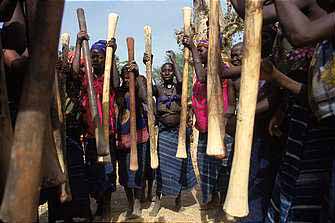
Millet Harvest - Dogon women pound millet in the village of Kani Kombal. Millet is of vital importance to the Dogon. They sow millet in June and July, after the rains begin. The millet is harvested in October.
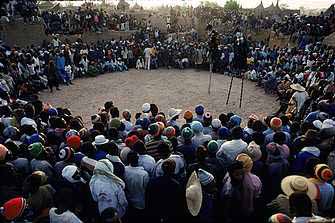
Nowadays, the Dogon blacksmiths forge mainly scrap metal recuperated from old railway lines or car wrecks. So, little by little, the long process of iron ore reduction, which demands a perfect knowledge of fire and its temperatures, has been abandoned.
One of the last smelting was done in Mali, in 1995, by the Dogon blacksmiths. The event became the subject of a film which was entitled 'Inagina, The Last House of Iron'. Eleven blacksmiths, who still hold the secrets of this ancestral activity, agreed to perform a last smelt. They gathered to invoke the spirits.
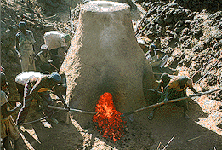
They sunk a mine shaft, made charcoal, and built a furnace with earth and lumps of slag. The last furnace - or Inagina -meaning literally the 'house of iron' gave birth to 69 kilos of iron of excellent quality. With this, the blacksmiths forged traditional tools intended for agriculture, the making of weapons, and jewelry for the
Dogon people
Youdiou Dances - During the Dama celebration, Youdiou villagers circle around two stilt dancers. The dance and costumes imitate the tingetange, a long-legged water bird. The dancers execute difficult steps while teetering high above the crowd.
The cult of Binu is a totemic practice and it has complex associations with the Dogon's sacred places used for ancestor worship, spirit communication and agricultural sacrifices. Marcel Griaule and his colleagues came to believe that all the major Dogon sacred sites were related to episodes in the Dogon myth of the creation of the world, in particular to a deity named Nommo.
Binu shrines house spirits of mythic ancestors who lived in the legendary era before the appearance of death among mankind. Binu spirits often make themselves known to their descendants in the form of an animal that interceded on behalf of the clan during its founding or migration, thus becoming the clan's totem.
The priests of each Binu maintain the sanctuaries whose facades are often painted with graphic signs and mystic symbols. Sacrifices of blood and millet porridge the primary crop of the Dogon are made at the Binu shrines at sowing time and whenever the intercession of the immortal ancestor is desired. Through such rituals, the Dogon believe that the benevolent force of the ancestor is transmitted to them.
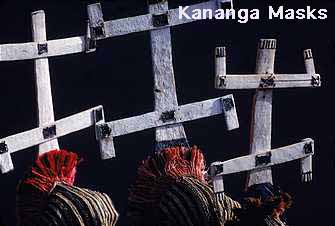
Kananga masks contain geometric patterns. These masks represent the first human beings. The Dogon believe that the Dama dance creates a bridge into the supernatural world. Without the Dama dance, the dead cannot cross over into peace.
Their self-defense comes from their social solidarity which is based on a complex combination of philosophic and religious dogmas, the fundamental law being the worship of ancestors. Ritual masks and corpses are used for ceremonies and are kept in caves. The Dogon are both Muslims and Animists.
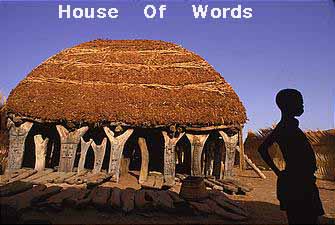
A 'Togu Na' - 'House of Words' - stands in every Dogon village and marks the male social center. The low ceiling, supported by carved or sculptured posts, prevents over zealous discussions from escalating into fights. Symbolic meaning surrounds the Togu Na. On the Gondo Plain, Togu Na pillars are carved out of Kile wood and often express themes of fertility and procreation. Many of the carvings are of women's breasts, for as a Dogon proverb says, "The breast is second only to God."
Unfortunately, collectors have stolen some of the more intricately carved pillars, forcing village elders to deface their Togu Na posts by chopping off part of the sculpted wood. This mutilation of the sculpted pillars assures their safety.
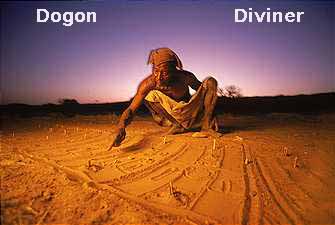
Amaguime Dolu, a diviner in the village of Bongo, performs a ritual. He derives meaning and makes predictions from grids and symbols in the sand. At dusk, he draws a questions in the sand for the sacred fox to answer. The Dogon people believe the fox has supernatural powers. The Dogon may ask questions such as: "Does the man I love also love me?" or "Should I take the job offer at the mission church?" In the morning, the diviner will read the fox prints on the sand and make interpretations. The fox is sure to come because offerings of millet, milk and peanuts are made to this sacred animal.
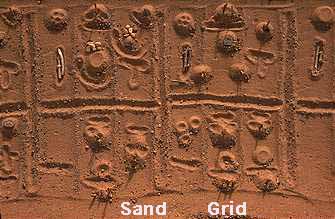
Dogon Wikipedia
Nommo
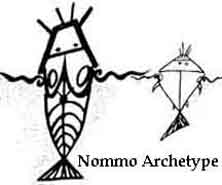
Astronomy
The Dogon are famous for their astronomical knowledge taught through oral tradition, dating back thousands of years, referencing the star system, Sirius linked with the Egyptian goddess Isis. The astronomical information known by the Dogon was not discovered and verified until the 19th and 20th centuries, making one wonder how the Dogon came by this knowledge. Their oral traditions say it was given to them by the Nommo. The source of their information may date back to the time of the ancient Egyptian priests.
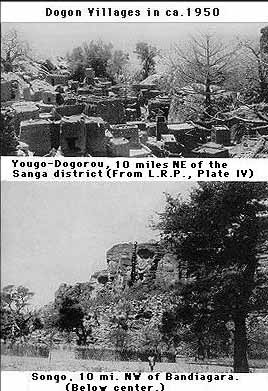
As the story goes ... in the late 1930s, four Dogon priests shared their most important secret tradition with two French anthropologists, Marcel Griaule and Germain Dieterlen after they had spent an apprenticeship of fifteen years living with the tribe. These were secret myths about the star Sirius, which is 8.6 light years from the Earth.
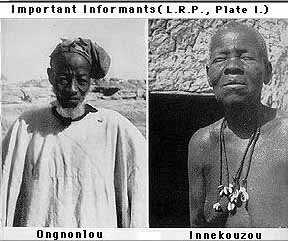
The Dogon priests said that Sirius had a companion star that was invisible to the human eye. They also stated that the star moved in a 50-year elliptical orbit around Sirius, that it was small and incredibly heavy, and that it rotated on its axis.
Initially the anthropologists wrote it off publishing the information in an obscure anthropological journal, because they didn't appreciate the astronomical importance of the information.
What they didn't know was that since 1844, astronomers had suspected that Sirius A had a companion star. This was in part determined when it was observed that the path of the star wobbled.
In 1862 Alvan Clark discovered the second star making Sirius a binary star system (two stars).
In the 1920's it was determined that Sirius B, the companion of Sirius, was a white dwarf star. White dwarfs are small, dense stars that burn dimly. The pull of its gravity causes Sirius' wavy movement. Sirius B is smaller than planet Earth.
The Dogon name for Sirius B is Po Tolo. It means star - tolo and smallest seed - po. Seed refers to creation. In this case, perhaps human creation. By this name they describe the star's smallness. It is, they say, the smallest thing there is. They also claim that it is 'the heaviest star' and is white in color. The Dogon thus attribute to Sirius B its three principal properties as a white dwarf: small, heavy, white.
Nommo Description
The Nommo are ancestral spirits (sometimes referred to as deities) worshipped by the Dogon tribe of Mali. The word Nommos is derived from a Dogon word meaning, "to make one drink," The Nommos are usually described as amphibious, hermaphroditic, fish-like creatures. Folk art depictions of the Nommos show creatures with humanoid upper torsos, legs/feet, and a fish-like lower torso and tail. The Nommos are also referred to as "Masters of the Water", "the Monitors", and "the Teachers".
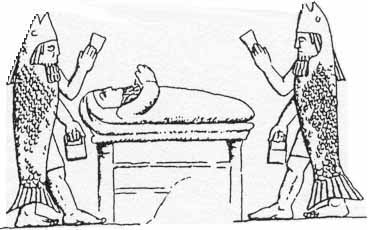
Nommo can be a proper name of an individual, or can refer to the group of spirits as a whole. For purposes of this article "Nommo" refers to a specific individual and "Nommos" is used to reference the group of beings.
Nommo Mythology
Dogon mythology states that Nommo was the first living creature created by the sky god Amma. Shortly after his creation, Nommo underwent a transformation and multiplied into four pairs of twins. One of the twins rebelled against the universal order created by Amma. To restore order to his creation, Amma sacrificed another of the Nommo progeny, whose body was dismembered and scattered throughout the world. This dispersal of body parts is seen by the Dogon as the source for the proliferation of Binu shrines throughout the Dogons¹ traditional territory; wherever a body part fell, a shrine was erected.
In the latter part of the 1940s, French anthropologists Marcel Griaule and Germaine Dieterlen (who had been working with the Dogon since 1931) were the recipients of additional, secret mythologies, concerning the Nommo. The Dogon reportedly related to Griaule and Dieterlen a belief that the Nommos were inhabitants of a world circling the star Sirius.
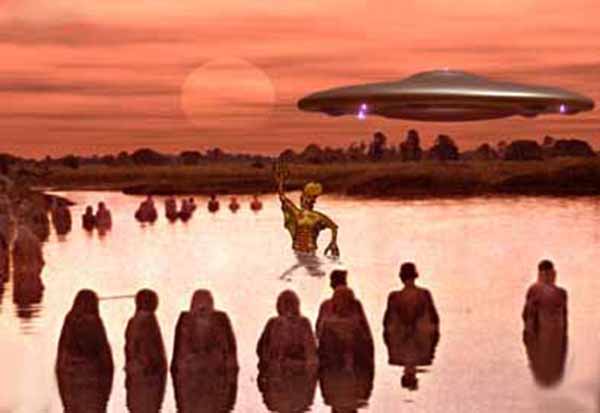
The Nommos descended from the sky in a vessel accompanied by fire and thunder. After arriving, the Nommos created a reservoir of water and subsequently dove into the water. The Dogon legends state that the Nommos required a watery environment in which to live. According to the myth related to Griaule and Dieterlen: "The Nommo divided his body among men to feed them; that is why it is also said that as the universe "had drunk of his body," the Nommo also made men drink. He gave all his life principles to human beings." The Nommo was crucified on a tree, but was resurrected and returned to his home world. Dogon legend has it that he will return in the future to revisit the Earth in a human form.
Controversy
In the 1970¹s a book by Robert Temple titled The Sirius Mystery popularized the traditions of the Dogon concerning Sirius and the Nommos. In The Sirius Mystery, Temple advanced the conclusion that the Dogon¹s knowledge of astronomy and non-visible cosmic phenomenon could only be explained if this knowledge had been imparted upon them by an extraterrestrial race that had visited the Dogon at some point in the past. Temple related this race to the legend of the Nommos and contended that the Nommos were extraterrestrial inhabitants of the Sirius star system who had traveled to earth at some point in the distant past and had imparted knowledge about the Sirius star system as well as our own solar system upon the Dogon tribes.
Walter van Beek, an anthropologist studying the Dogon, found no evidence that they had any historical advanced knowledge of Sirius. Van Beek postulated that Griaule engaged in such leading and forceful questioning of his Dogon sources that new myths were created in the process by confabulation.
Carl Sagan has noted that the first reported association of the Dogon with the knowledge of Sirius as a binary star was in the 1940¹s, giving the Dogon ample opportunity to gain cosmological knowledge about Sirius and the solar system from more scientifically advanced, terrestrial societies whom they had come in contact with. It has also been pointed out that binary star systems like Sirius are theorized to have a very narrow or non-existent Habitable zone, and thus a high improbability of containing a planet capable of sustaining life (particularly life as dependent on water as the Nommos were reported to be).
Daughter and colleague of Marcel Griaule, Genevieve Calame-Griaule, defended the project, dismissing Van Beek's criticism as misguided speculation rooted in an apparent ignorance of esoteric tradition. Van Beek continues to maintain that Griaule was wrong and cites other anthropologists who also reject his work The assertion that the Dogon knew of another star in the Sirius system, Emme Ya, or "larger than Sirus B but lighter and dim in magnitude" continues to be discussed.
In 1995, gravitational studies indicated the possible existence of a red dwarf star circling around Sirius but further observations have failed to confirm this.
Space journalist and skeptic James Oberg collected claims that have appeared concerning Dogon mythology in his 1982 book and concedes that such assumptions of recent acquisition is "entirely circumstantial" and has no foundation in documented evidence and concludes that it seems likely that the Sirius mystery will remain exactly what its title implies; a mystery.
Earlier, other critics such as the astronomer Peter Pesch and his collaborator Roland Pesch and Ian Ridpath had attributed the supposed "advanced" astronomical knowledge of the Dogon to a mixture of over-interpretation by commentators and cultural contamination.
Nommo Wikipedia The Dogon Code: Linking Egypt and West Africa
John Anthony West interviews Laird Scranton About his book: "Hidden Meanings". Scranton explains how the Dogon tribe in West Africa originated Egyptian symbolism, philosophy, physics and even modern science. Excerpts from Magical Egypt series.
Part 1 of 5
Part 2 of 5
Part 3 of 5
Part 4 of 5
Part 5 of 5
2012 Ufo's Aliens The Dogon Sirius Mystery
The Dogon tribe in Mali West Africa have been telling their story of an Extraterrestrial visitation in the past, by beings from the Star Sirius B sometime around 8,000 years ago.
Even though this star cannot have been seen by them visually because it can only be seen by looking through a fairly advanced telescope.
They also have in depth knowledge about a very small red dwarf star Sirius C which was only discovered by Astronomers in1995. They also knew that planet Jupiter has 4 Moons and described the visiting Craft and Extraterrestrials in great detail.
Robert Temple Scientist and researcher published his first book in 1976 and predicted that Sirius C would be found from information obtained from the Dogon Tribe.
Robert Temple Website at
http://www.robert-temple.com/
http://www.robert-temple.com/
Part 1 of 4
Part 2 of 4
Part 3 of 4
Part 4 of 4
The Sirius Mystery - Interview with Robert Temple
Watch on: Youtube
This video is a new edit by Nabil Shaban, of the interview which originally featured in the Zentropa Documentary, "Return of the Star People", which was produced and directed by Bente Milton in 2003.
The Dogon Tribe Part 1
The Dogon Tribe Part 2
The Sirius Star System, The Dogon Tribe and NASA Tether Incident
Part 1 of 2
Part 2 of 2






No comments:
Post a Comment